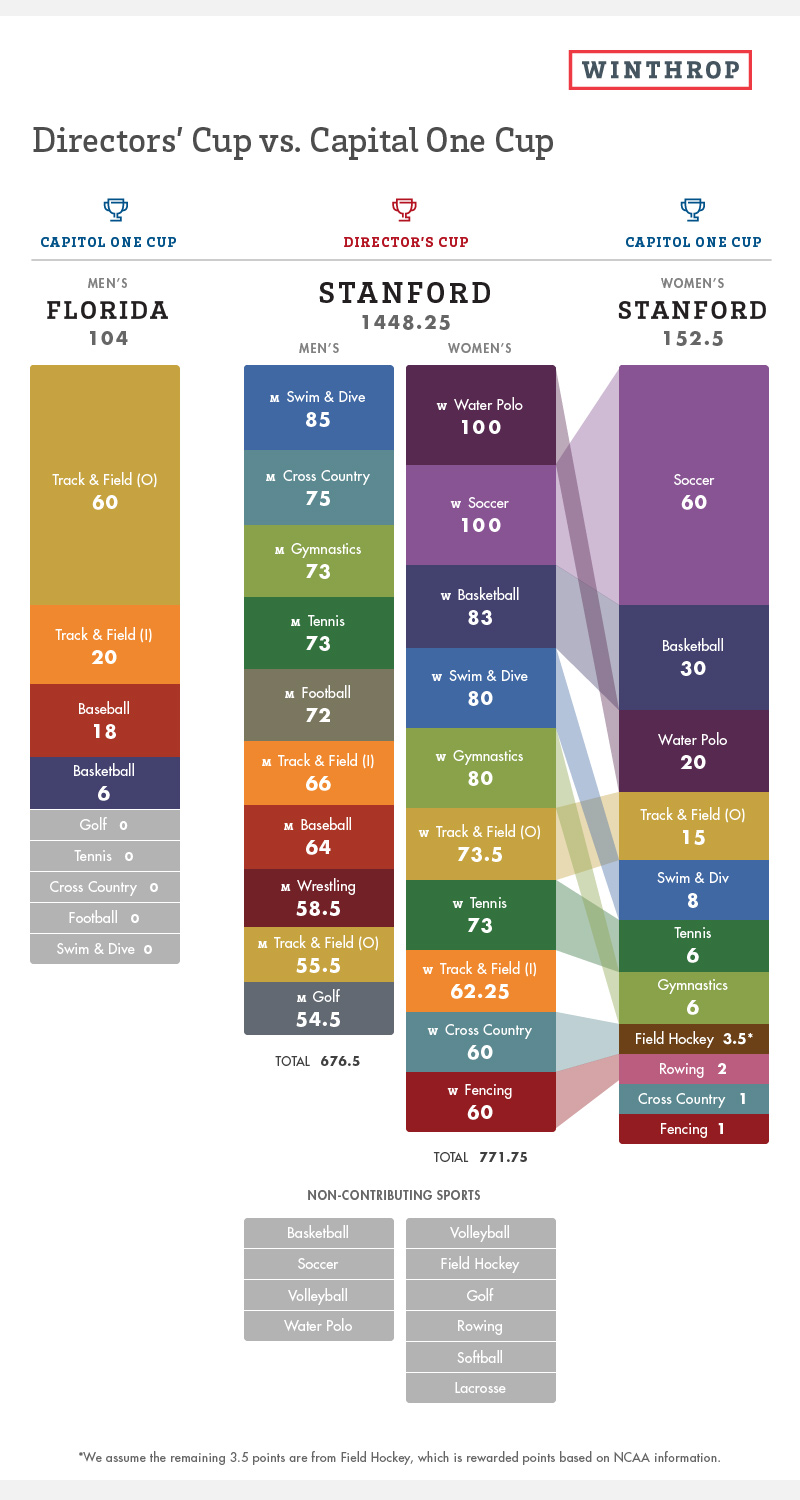The “success” of an athletic department is an awfully abstract notion. Is the successful department the one that wins the most championships? The one that wins certain championships? The one with the greatest sport depth? Or does the successful department exhibit something else entirely? Indeed, the complexion of a successful athletic department appears to be a varied and layered mess of qualities even before one considers its further academic and fiscal responsibilities.
At least regarding NCAA competition, two organizations currently implement systems that quantify department-wide success. Since the 1993-1994 academic year, the National Association of Collegiate Directors’ of Athletics (NACDA) had implemented the sole standard for Division I programs—the Learfield Directors’ Cup—to the school whose combined men’s and women’s programs finished atop NACDA’s year-end standings. In 2010, the NCAA and corporate sponsor Capital One teamed up to forge the Capital One Cup, which would likewise award a trophy, and additionally grant $200,000 in graduate scholarships, to each school sitting first in its final rankings for men’s and women’s D-I athletics.
Despite serving ostensibly similar functions, these two award systems have produced wildly different end results in their brief coexistence. This past 2011-2012 season, only six schools within the Directors’ Cup’s final top ten finished in the top ten in either of the Capital One Cup’s men’s and women’s standings (standings which notably boasted a combined 12 schools that didn’t crack the top ten in the Directors’ Cup).
Why so much disparity between two ranking systems with such similar goals? Because the Directors’ Cup and the Capital One Cup employ surprisingly dissimilar scoring methodologies, each in its own way biased towards certain kinds of sports.
The most obvious difference is their treatment of men’s and women’s sports: The Directors’ Cup combines men’s and women’s programs, while the Capital One Cup rewards each separately. More specifically, the Directors’ Cup tallies its final total from each school’s ten best-scoring men’s performances and ten best-scoring women’s performances, while the Capital One Cup compiles each of its gender-based totals from 20 women’s sports and 20 men’s sports (though that includes two performances from FCS and FBS football, of which no men’s program could field both).
Since Capital One ranks men’s and women’s sports separately, there’s no real advantage for the women in this regard, but does allow for more variety in the men’s top ten because of Capital One’s tiered point allocation.
While the Directors’ Cup values each sport equitably (national champions in, say, skiing and FBS football both earn 100 points), the Capital One Cup assigns different point scales dependent upon whether the sport falls within Group A or Group B, divisions segregated by factors including fan interest and attendance among others. National champions in the more popular Group B (comprising baseball, basketball, football, lacrosse, outdoor track & field, soccer, softball, and volleyball) receive 60 points, while the rest of the sports in Group A earn 20 points.
The result of such a precipitous scale between the two groups is that almost all schools with a Group B championship occupy spots in the final Capital One Cup top ten. In its inaugural season, every men’s and women’s Group B champion came from a program that finished seventh or higher in its respective standings. This past season, the schools winning all but two Group B championships (Baylor in women’s basketball and Northwestern in women’s lacrosse, the exceptions) finished within the final top ten (Baylor and Northwestern both finished just two points shy of tenth in the women’s rankings on final point tallies pulled entirely from their Group B national championships).
Because the Capital One Cup awards an additional 60-point national champion for the men, and especially because the Cup reserves it for an FCS school and thus from any BCS power, the men will likely total fewer points and show more variety, as exemplified by Eastern Washington’s seventh-place finish in 2011, and North Dakota State’s tenth-place finish in 2012, both carried entirely by FCS football championships.
Compare that to the Directors’ Cup, where, because all champions are treated equally, only four schools that took Group B championships finished in the top ten of the final 2012 standings. Because the Directors’ Cup stresses program breadth so heavily, an Eastern Washington or North Dakota State would certainly be hard-pressed to sniff anywhere near the top 50. Even of the traditional BCS powers find it impossible to topple Stanford, winner of 18-consecutive Directors’ Cups since North Carolina earned the inaugural trophy in 1994.
Stanford enjoys a decided advantage due to its ability to field 36 varsity teams. Since the Directors’ Cup only considers the ten best-scoring men’s and women’ programs, the Cardinal can weather a bad performance in one sport a lot better than say, Oregon, who leaves points on the board since it only fields 18 NCAA teams. In fact, in 2012, Stanford had so many women’s sports finish in their respective top tens, that ninth place finishes in field hockey and rowing did not even factor into its final point total.
So what can an AD do to climb the standings of either cup? Well, the easy answer is to add sports. Neither Cup is an average of its entire program’s success, but a cumulative sum of individual sport performances. For the Capital One Cup, adding or emphasizing Group B sports might improve a school’s chances, but a national championship in any of those is likely not a once-a-year occurrence. For the Directors’ Cup, the solution might be to add a bunch of sports. But who has the wherewithal to field a program anywhere near as prolific as at Stanford?
A deeper look at each of the two systems reveals that even within the Capital One Cup’s Group A, or Group B, or even among all the rhetorically equitable sports of the Directors’ Cup, points are easier to collect in some sports than in others.
Easy to come by points are more prominent in the Capital One Cup, which allocates points on a sliding scale to ten teams in every sport, regardless of how many different schools field Division I programs in that sport.
Ten of the 63 Division I men’s lacrosse programs (or 15.87%) split 213 points, just as ten of the 349 Division I men’s basketball programs (2.87%) also split 213 points, or ten of the 91 Division I women’s lacrosse programs (10.99%), or ten of the 345 Division I women’s basketball programs (2.90%).
And in group B, ten of the 326 Division I women’s tennis teams (3.07%) share 71 points, just as ten of the 25 (40%) fencing programs do. Because of the Capital One Cup’s scoring method, a program is likely to score higher if it targets sports in which it faces less competition.
In the Directors’ Cup, the scoring structure varies sport by sport, depending on whatever postseason format each sport uses to determine its champion. Postseason formats fall into three categories: bracket sports, non-bracket sports, and, always the outlier, FBS football (though the FBS moniker and its format will change in 2014).
- In bracket sports, those whose postseasons involve round-by-round tournaments, only tournament qualifiers receive anywhere from 25-100 points, depending on the stage reached.
- In non-bracket sports, those whose postseasons involve championship invites that place teams individually, the Directors’ Cup distributes a sliding scale from 10-100 according to each sport’s championship standing. For sports whose championships award teams 65th or lower, those teams receive a flat five points.
- In FBS football, teams ranked in the Final USA Today Coaches Poll receive anywhere from 100 points for first, to 49 points for 25th. Additionally, unranked bowl game winners receive 45 points, and unranked bowl game losers receive 25 points.
In general, the Directors’ Cup awards a postseason appearance, so sports that admit a larger percentage of teams to their postseason fields produce the best Directors’ Cup ROI.
The BCS’s notoriously inclusive bowl system means that over 70 of the 123 FBS programs (56.91%) will receive at least 25 points, while the more selective playoff used by its FCS counterpart reaps at least 25 points for only 24 of its 122 teams (19.67%).
But for all the flack the BCS gets about how generously it extends postseason invites, it hardly offers the Directors’ Cup odds that fencing does. In 2012, nineteen of the 25 schools that field D-I fencing programs (76%) earned at least 35 points, on average, 46.60 points per program, or 61.32 per program earning points.
Since fencing counts towards the women’s total score, compare that to women’s basketball, where only 18.34% of all programs earned at least 25 points, or 7.91 points per D-I women’s basketball program and an average of 43.125 per program receiving points.
Further, most of these more rewarding sports count towards the women’s totals, and taken along with the fact that women’s sports are generally less established [RDM1] than men’s sports (and thus experience less parity), might help explain why institutions investing more heavily in women’s sports would probably see their investments translate into higher Directors’ Cup totals. 1
The Directors’ Cup and Capital One Cup represent the most tangible measures of an athletic department’s endeavors and initiatives. But as sophisticated and nuanced as their metrics may be, both systems are not completely without their biases.
While larger programs may enjoy a sizable advantage in both cups, shrewd ADs at smaller schools can certainly still elevate their programs’ Capital One Cup scores by targeting Group B sports, or in sports with fewer programs fielding competitive teams; or attempt to improve their Directors’ Cup scores, either by targeting their women’s programs, or sports in which a larger percentage of eligible teams qualify for postseason play.
Key Insights
Despite serving similar functions, the Directors’ Cup and Capital One Cup employ surprisingly dissimilar scoring methodologies, each biased towards certain kinds of sports. There are areas that an AD can focus on to climb the standings of both cups. The easy answer is to add sports. Easy to come by points are more prominent in the Capital One Cup, which allocates points on a sliding scale to ten teams in every sport, regardless of how many different schools field Division I programs in that sport. In general, the Directors’ Cup awards a postseason appearance, so sports that admit a larger percentage of teams to their postseason fields produce the best Directors’ Cup ROI.
References:
- This is a takeaway suggested by a 2012 Ohio University study on the Directors’ Cup (Journal of Issues in Intercollegiate Athletics 218-219).
Lawrence, Heather J., Ming Li, John S. Regas, and Jon Kander. “National Association of Collegiate Directors’ of Athletics Directors’’ Cup Standings: Predictors of Success.” Journal of Issues in Intercollegiate Athletics 5 (2012): 207-24. Web.





